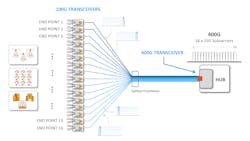BT has modelled the performance of Infinera’s (NASDAQ:INFN) coherent point-to-multipoint XR optics technology as well as conducted lab exercises using prototypes. As the two companies will describe in a paper to be delivered during ECOC 2020, the modelling indicates the use of XR optics in a metro scenario could produce a greater than 70% savings in capex over a five-year period versus a reference architecture based on conventional point-to-point optics.
Infinera unveiled XR optics at ECOC 2019 last fall (see “Infinera unveils XR optics single-source coherent point-to-multipoint transmission technology”). XR optics leverages the ability of the company’s Infinite Capacity Engine (ICE) to create and transmit Nyquist subcarriers and what Infinera calls “coherent subcarrier aggregation” (CSA). CSA enables individual 25-Gbps subcarriers or subcarrier bundles to be distributed to multiple end points. The end points would not have to use all of the subcarriers assigned to it initially, which opens the possibility of pay-as-you-grow or event-based capacity increases between the hub and its attendant nodes. The technology would be housed in pluggable optical transceivers installed in routers at both ends. Both ends would need to have XR optics interfaces for the scheme to succeed. Infinera initially is targeting 400G for hub optics.
Infinera asserts the use of XR optics should lead to significant cost savings from the reduction of router ports necessary at hub locations as well as intermediate line systems between the hub and its attendant nodes. BT was intrigued enough to model the technology’s application to metro networks this past May. According to Andrew Lord, senior manager, optical research at BT and a co-author of the ECOC paper, the service provider connects its metro nodes in chains, with 5 to 10 nodes per chain. The chains link into hubs at both ends (for redundancy) for passing of aggregated traffic toward the core. The resultant hub-and-spoke architecture is the type of application for which Infinera envisions XR optics to have the most benefit.
The modelling saw a filterless architecture based on XR optics compared with a more traditional point-to-point approach that uses ROADMs, transponders, and conventional 100G and 400G optical transceivers. The effect on capex of an approximate 30% per year growth in traffic was evaluated as part of the modelling. The filterless XR optics approach generated 74% capex savings in the first year, rising to 76% in the fifth. The ability to break traffic into 25G increments provided significant improvements in capacity utilization as well.
Lord said the exercise did not attempt to estimate potential opex savings. David Welch, founder and chief innovation officer at Infinera (and another co-author on the paper), said neither his company nor other potential customers who have examined the XR optics concept have estimated opex formally either – but that significant opex savings should accrue as well.
BT also took the opportunity to run some lab exercises with prototypes of the XR optics technology. The lab work focused on broadband services scenarios, with a model metro network with PON overlays and straight PONs among the applications considered. Lord said the technology performed well enough to spark interest in potential field trials once XR optics is commercialized, likely in the second half of 2021. Welch noted that management-related capabilities will likely be available in the first half of next year, with the necessary ASIC ready subsequently.
Infinera plans to bring XR optics enabled modules to market via a partner ecosystem. II-VI (NASDAQ:IIVI) and Lumentum (NASDAQ:LITE) have raised their hands so far (see “Infinera reveals II-VI, Lumentum as XR optics partners”).
For related articles, visit the Optical Technologies Topic Center.
For more information on optical modules and suppliers, visit the Lightwave Buyer’s Guide.
To stay abreast of optical communications technology, subscribe to Lightwave’s Enabling Technologies Newsletter.

Stephen Hardy | Editorial Director and Associate Publisher, Lightwave
Stephen Hardy is editorial director and associate publisher of Lightwave and Broadband Technology Report, part of the Lighting & Technology Group at Endeavor Business Media. Stephen is responsible for establishing and executing editorial strategy across the both brands’ websites, email newsletters, events, and other information products. He has covered the fiber-optics space for more than 20 years, and communications and technology for more than 35 years. During his tenure, Lightwave has received awards from Folio: and the American Society of Business Press Editors (ASBPE) for editorial excellence. Prior to joining Lightwave in 1997, Stephen worked for Telecommunications magazine and the Journal of Electronic Defense.
Stephen has moderated panels at numerous events, including the Optica Executive Forum, ECOC, and SCTE Cable-Tec Expo. He also is program director for the Lightwave Innovation Reviews and the Diamond Technology Reviews.
He has written numerous articles in all aspects of optical communications and fiber-optic networks, including fiber to the home (FTTH), PON, optical components, DWDM, fiber cables, packet optical transport, optical transceivers, lasers, fiber optic testing, and more.
You can connect with Stephen on LinkedIn as well as Twitter.
